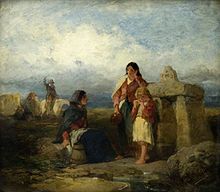Francis William Topham

Francis William Topham (
Life
His early in life he was articled to an uncle who was a writing engraver. Around 1830 he came to London, and at first found employment in engraving
Topham first visited Ireland in 1844 and 1845, with
In the winter of 1876 Topham again went to Spain, dying in
Works
Topham's earliest exhibited work was The Rustic's Meal, which appeared at the

Topham also made designs for Fisher, Son & Co.'s edition of the

The earliest of Topham's Spanish subjects appeared in 1854, when he exhibited Fortune Telling — Andalusia, and Spanish Gypsies 29,5 x 38,5 cm. These paintings were followed by The Andalusian Letter-Writer and The Posada in 1855, Spanish Card-players and Village Musicians in Brittany in 1857, Spanish Gossip in 1859, and others, mainly Spanish. In the autumn of 1860 he paid a return visit to Ireland, and in 1861 exhibited The Angel's Whisper and Irish Peasants at the Holy Well. In 1864 he began to exhibit Italian drawings, sending Italian Peasants and The Fountain at Capri, and in 1870 A Venetian Well.[1]

Four of Topham's drawings, Galway Peasants, Irish Peasant Girl at the foot of a Cross, Peasants at a Fountain, Basses-Pyrénées, and South Weald Church, Essex, went to the
- The Spinning Wheel and The Sisters at the Holy Well, by Francis Holl;
- Irish Courtship, by F. W. Bromley;
- Making Nets, by Thomas Oldham Barlow;
- The Mother's Blessing, by William Henry Simmons; and
- The Angel's Whisper, for The Art Journal of 1871, by C. W. Sharpe.
Family
While with Fenner & Sears, Topham met Henry Beckwith the engraver, and married his sister Mary Anne Beckwith in 1832. They had ten children. Their son Frank William Warwick Topham (1838–1924) became known as a painter.[1][2]

Notes
- ^ a b c d e f g h Lee, Sidney, ed. (1899). . Dictionary of National Biography. Vol. 57. London: Smith, Elder & Co.
- ^ doi:10.1093/ref:odnb/27552. (Subscription or UK public library membershiprequired.)
External links
![]() Media related to Francis William Topham at Wikimedia Commons
Media related to Francis William Topham at Wikimedia Commons
- 9 artworks by or after Francis William Topham at the Art UK site
 Prince Charles Edward bidding adieu to his Friends., engraved by G Presbury for Fisher's Drawing Room Scrap Book, 1839 with a poetical illustration by Letitia Elizabeth Landon.
Prince Charles Edward bidding adieu to his Friends., engraved by G Presbury for Fisher's Drawing Room Scrap Book, 1839 with a poetical illustration by Letitia Elizabeth Landon.
- Attribution
![]() This article incorporates text from a publication now in the public domain: Lee, Sidney, ed. (1899). "Topham, Francis William". Dictionary of National Biography. Vol. 57. London: Smith, Elder & Co.
This article incorporates text from a publication now in the public domain: Lee, Sidney, ed. (1899). "Topham, Francis William". Dictionary of National Biography. Vol. 57. London: Smith, Elder & Co.
